Therapeutic effects of telomerase in mice with pulmonary fibrosis induced by damage to the lungs and short telomeres
- PMID: 29378675
- PMCID: PMC5818250
- DOI: 10.7554/eLife.31299
Therapeutic effects of telomerase in mice with pulmonary fibrosis induced by damage to the lungs and short telomeres
Abstract
Pulmonary fibrosis is a fatal lung disease characterized by fibrotic foci and inflammatory infiltrates. Short telomeres can impair tissue regeneration and are found both in hereditary and sporadic cases. We show here that telomerase expression using AAV9 vectors shows therapeutic effects in a mouse model of pulmonary fibrosis owing to a low-dose bleomycin insult and short telomeres. AAV9 preferentially targets regenerative alveolar type II cells (ATII). AAV9-Tert-treated mice show improved lung function and lower inflammation and fibrosis at 1-3 weeks after viral treatment, and improvement or disappearance of the fibrosis at 8 weeks after treatment. AAV9-Tert treatment leads to longer telomeres and increased proliferation of ATII cells, as well as lower DNA damage, apoptosis, and senescence. Transcriptome analysis of ATII cells confirms downregulation of fibrosis and inflammation pathways. We provide a proof-of-principle that telomerase activation may represent an effective treatment for pulmonary fibrosis provoked or associated with short telomeres.
Keywords: AAV9; chromosomes; gene therapy; genes; mouse; pulmonary fibrosis; telomerase; telomeres.
© 2018, Povedano et al.
Conflict of interest statement
JP, PM, RS, ÁT, GG, JF, FB, MB No competing interests declared, MB is an employee for F. Hoffmann-La Roche Ltd, and the author declares no other competing financial interests
Figures
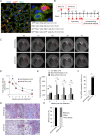

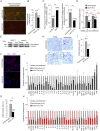

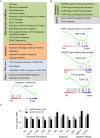
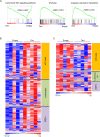
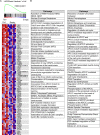


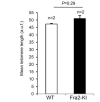
Similar articles
-
Telomerase reverse transcriptase ameliorates lung fibrosis by protecting alveolar epithelial cells against senescence.J Biol Chem. 2019 May 31;294(22):8861-8871. doi: 10.1074/jbc.RA118.006615. Epub 2019 Apr 18. J Biol Chem. 2019. PMID: 31000627 Free PMC article.
-
AAV9-mediated telomerase activation does not accelerate tumorigenesis in the context of oncogenic K-Ras-induced lung cancer.PLoS Genet. 2018 Aug 16;14(8):e1007562. doi: 10.1371/journal.pgen.1007562. eCollection 2018 Aug. PLoS Genet. 2018. PMID: 30114189 Free PMC article.
-
Telomerase gene therapy rescues telomere length, bone marrow aplasia, and survival in mice with aplastic anemia.Blood. 2016 Apr 7;127(14):1770-9. doi: 10.1182/blood-2015-08-667485. Epub 2016 Feb 22. Blood. 2016. PMID: 26903545
-
Short telomeres in pulmonary fibrosis: from genetics to clinical significance.Pneumologia. 2015 Jan-Mar;64(1):8, 11-3. Pneumologia. 2015. PMID: 26016050 Review.
-
Telomeres in lung diseases.Prog Mol Biol Transl Sci. 2014;125:173-83. doi: 10.1016/B978-0-12-397898-1.00008-6. Prog Mol Biol Transl Sci. 2014. PMID: 24993703 Review.
Cited by
-
Repairing Mechanisms for Distal Airway Injuries and Related Targeted Therapeutics for Chronic Lung Diseases.Cell Transplant. 2023 Jan-Dec;32:9636897231196489. doi: 10.1177/09636897231196489. Cell Transplant. 2023. PMID: 37698245 Free PMC article. Review.
-
Shorter telomere lengths in patients with severe COVID-19 disease.Aging (Albany NY). 2021 Jan 11;13(1):1-15. doi: 10.18632/aging.202463. Epub 2021 Jan 11. Aging (Albany NY). 2021. PMID: 33428591 Free PMC article.
-
Causes of Pulmonary Fibrosis in the Elderly.Med Sci (Basel). 2018 Jul 24;6(3):58. doi: 10.3390/medsci6030058. Med Sci (Basel). 2018. PMID: 30042329 Free PMC article. Review.
-
Telomerase reverse transcriptase ameliorates lung fibrosis by protecting alveolar epithelial cells against senescence.J Biol Chem. 2019 May 31;294(22):8861-8871. doi: 10.1074/jbc.RA118.006615. Epub 2019 Apr 18. J Biol Chem. 2019. PMID: 31000627 Free PMC article.
-
Telomeres: Dysfunction, Maintenance, Aging and Cancer.Aging Dis. 2023 Nov 29;15(6):2595-2631. doi: 10.14336/AD.2023.1128. Aging Dis. 2023. PMID: 38270117 Free PMC article. Review.
References
-
- Alder JK, Guo N, Kembou F, Parry EM, Anderson CJ, Gorgy AI, Walsh MF, Sussan T, Biswal S, Mitzner W, Tuder RM, Armanios M. Telomere length is a determinant of emphysema susceptibility. American Journal of Respiratory and Critical Care Medicine. 2011;184:904–912. doi: 10.1164/rccm.201103-0520OC. - DOI - PMC - PubMed
Publication types
MeSH terms
Substances
LinkOut - more resources
Full Text Sources
Other Literature Sources
Medical
Molecular Biology Databases

